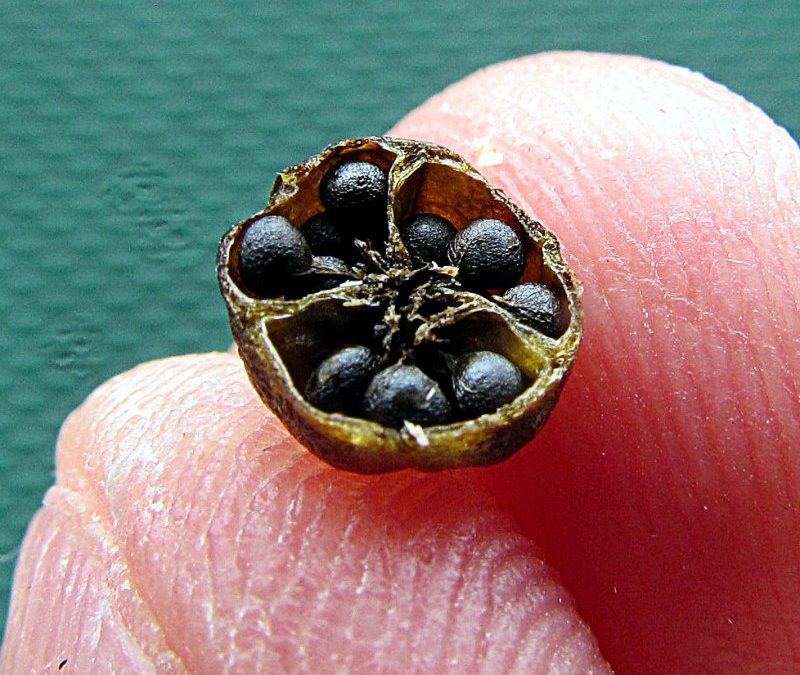Image: By Gmihail at Serbian Wikipedia (Own work) [CC BY-SA 3.0 rs (http://creativecommons.org/licenses/by-sa/3.0/rs/deed.en) or GFDL (http://www.gnu.org/copyleft/fdl.html)], via Wikimedia Commons
I volunteer at the botanic garden Tuesday mornings. The display of yellow Viola on the undeveloped portion of the hills was wonderful this year and it occurred to me that there would be lots of seeds. I would really like to have the propagation crew at the garden try to grow some of these as I think they would make a nice addition to our gardens. Granted they disappear in the heat of the summer but they could make a nice groundcover under some of our shrubs and need no water in the dry time. So I approached Eve. Eve is the person who started the garden as an extension of her senior project at Cal Poly. She was receptive to the idea. I asked if I could take a bit more for other uses. Again the answer was yes and extended to some of the other plants on the hills. So when I thought the seeds might be ready I ventured out.
These are hills that are brown in the summer. They are covered with oats and ripgut and some other not so nice plants. But there are patches of Viola and Sidalcea and Sisyrhincium. So I had a goal of collecting all three. Finding those patches was not always easy. The plants disappear into the dried grasses. But I could find some. And in my wandering looking for patches I was excited to discover that not only are there the invasive sorts of grasses but there was lots of Stipa pulcra, some Melica californica, Melica imperfecta (or at least a different kind of Melica), Elymus triticoides (I think), Elymus condensatus, Hordeum bracyantherum and the most exciting find, for me, was some Danthonia californica. I am not collecting seeds of those grasses because they are not represented in great numbers and I want all the seed that’s there to possibly increase populations. But I am collecting the seeds of the Viola, Sidalcea, and hopefully the Sisyrhincum.
However, patience is a requirement. Finding the patches of Viola was not nearly as challenging as finding the seeds ready to gather. I am honing my observational skills and getting up close and personal with the plants. I was looking for black, ripe seeds so black drew my attention. Often the black was a little beetle that I saw only on violets. Is this a good bug or a bad bug? I have no idea. But if it is providing food for the birds in my book it’s a good bug. Perhaps it’s one of those specialist bugs that only use one plant. Questions. Down on my knees I can see the developing seed capsules and I have observed that as they ripen they lift and point to the sky. Once ripe, the capsules pop open. Sometimes a few seeds remain in the opened capsule. Whether these are defective or not I don’t know but I have collected them. At least they are black. Picking a few capsules early results in green seeds. I have picked a few, unopened but upturned, which have resulted in the sound of popping seeds in the paper bags at home. I have gotten some black seeds out of these. My favorite find is to see the open capsule, still green, and filled with black seeds. Treasure! But it has taken weeks of venturing up on the hill to get a few tablespoons of seeds. Some of these will find their way to the seed exchange.
The Sidalcea is another story. I found that many of the flowers did not develop into seeds, but in some areas there were more that developed than others. Does this reflect the presence of more pollinators in some areas than others? In some areas the stalks were half gone. Are they browse for deer? More observations lead to more questions. But I did collect a few seeds that seemed to be ripe. The capsules on these plants seemed to dry with the seeds remaining in the capsule. But as they dried they would separate a bit and I found that if I just brushed my fingers across a capsule seeds would fall into my hand. I found capsules with just a few seeds remaining so assumed these were ripe. I don’t have many seeds of these but after sharing with the botanic garden a few will end up at the seed exchange. You should want these. I have a Sidalcea grown from seed that has been blooming for several months in my garden. I think it’s beautiful.
As for the Sisyrhincium, I don’t have seeds yet and am not sure that I will. Those patches, which were so obvious and seemed so huge when they were covered with their blue-purple blossoms, are very hard to find when there is no flower to beckon. Those that I have found are not yet ripe. The capsules are still green and I don’t know if I will have any luck finding ripe seeds. But I am going to try.
What about not having the right shoes? The shoes I wear at the botanic garden are really old worn out hiking shoes with that open mesh sort of fabric for breathability. They are really great grass seed collectors. Those seeds penetrate through the open mesh and through my smart wool socks and into my skin. Almost intolerable. Before I drive home I have to remove my shoes and get rid of those seeds. I am pleased to find that they collect Stipa seeds too which means that there are plenty of Stipa seeds to be had. But I am very conscious of the fact that I don’t want to be transferring these seeds to the trails so they are no longer used for hiking.
Reminder: Seed exchange before the October meeting.
-Marti Rutherford

